
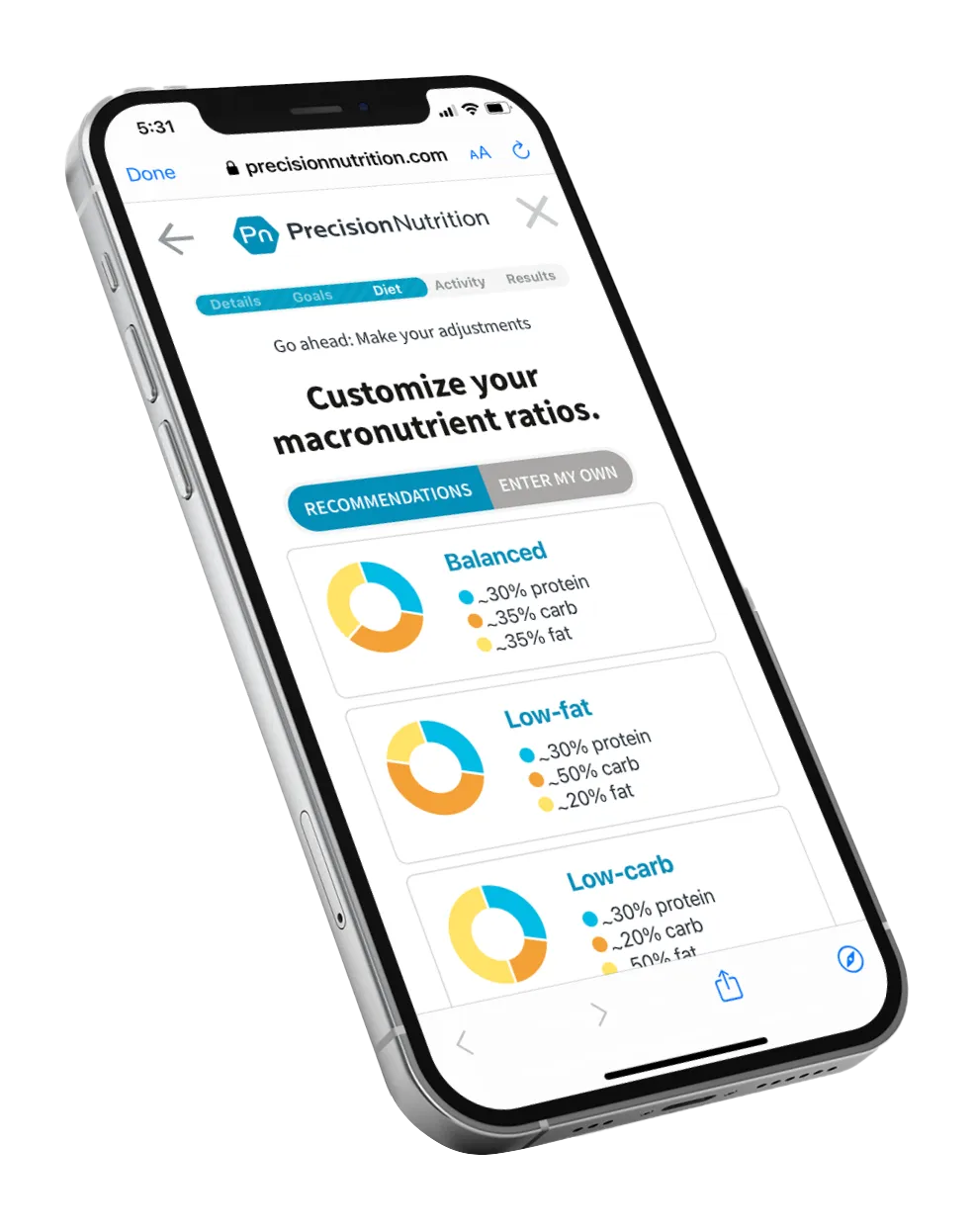
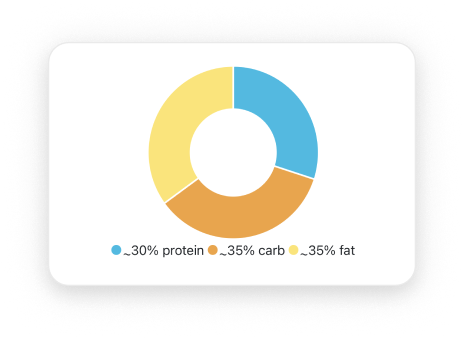
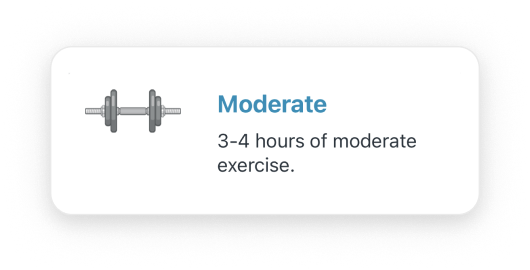
Reach Your Health and Fitness Goals with The
Ultimate Macro Calculator
Do you want to lose weight, gain muscle, improve your health, or boost your performance? Our macro calculator will provide you with a custom nutrition plan—complete with macros, calories, and portions—personalized for your body and your goals.
Macros for free:

Calculating Macros
Made Easy
This macro calculator was designed, developed, and tested in the Precision Nutrition research lab, and proven effective with thousands of clients. It takes into account your personal details, physical activity levels, metabolism, and goals to provide a comprehensive nutrition plan in just three easy steps.
Enter Your Info
Input your information including your physical activity levels, dietary preferences, and fitness goals.
Receive an Overview of Your Nutrition Plan
You’ll get a high level summary of the macro breakdown for your customized plan.
Download Complete Resources
Input your email and create an account to receive a free download of a completely personalized nutrition guide to hit your targets.
Ready to achieve your fitness goals? Don’t let nutrition stand in the way.
Features of Our Custom Macro Calculator
The Precision Nutrition Macro Calculator first determines the appropriate daily calories for your body, based on the NIH Body Weight Planner (and adapted from research collected at the National Institute of Diabetes and Digestive and Kidney Disease).
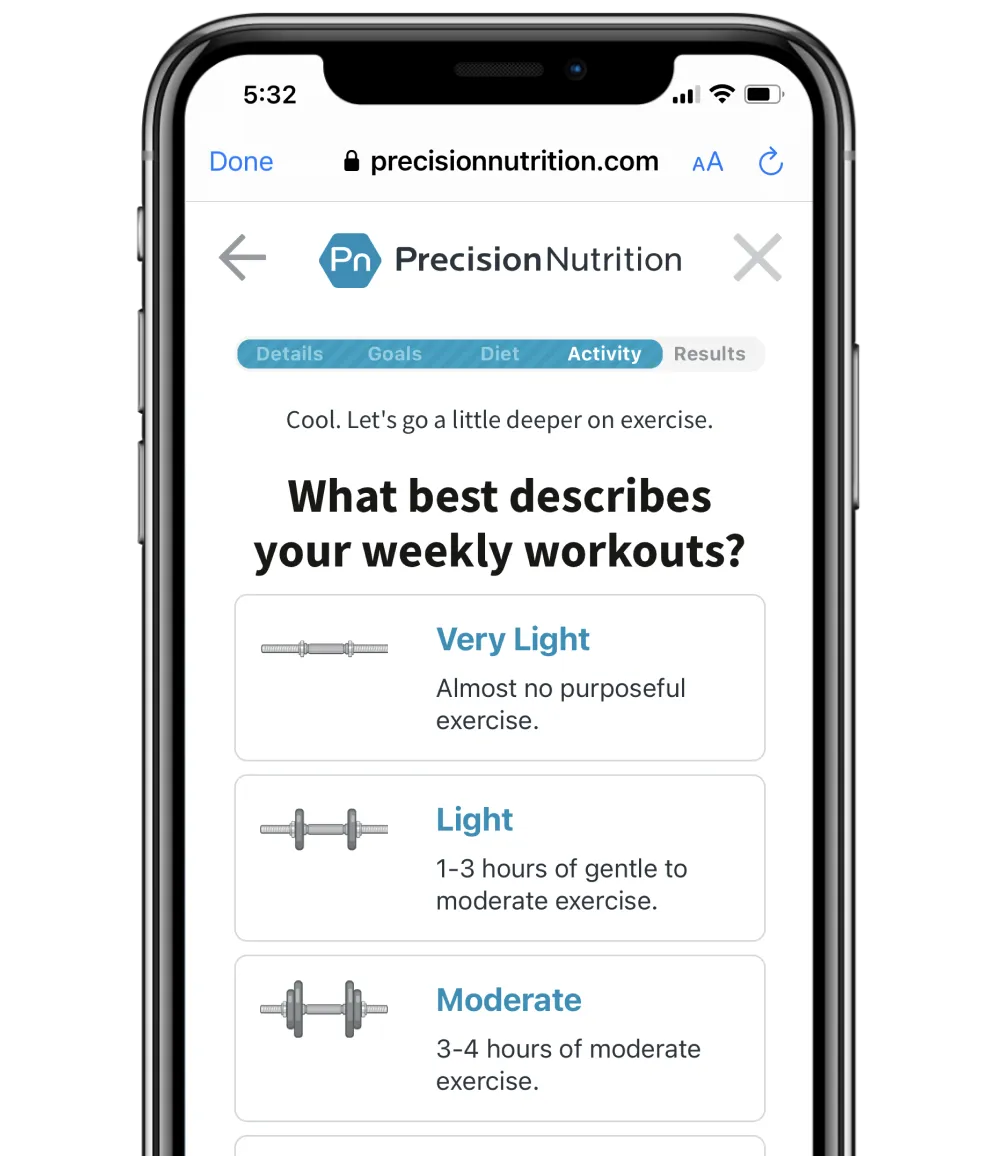
A Comprehensive Assessment
This ultimate macro calculator takes a complete and comprehensive look at your life to provide a personalized nutrition recommendation. It takes into account:
- Personal details (height, age, weight, sex)
- Physical activity levels (both daily movement and purposeful exercise)
- Nutrition and fitness goals (weight loss, muscle gain, body recomposition, improved health)
- The date by which you want to reach your goal (within reason!)
- Dietary preferences (paleo, keto, vegetarian, plant-based, Mediterranean, and more)
- Macronutrient ratio preferences (examples: balanced, low-fat, low-carb)
- The adaptive nature of the human metabolism
Using all of this information, it then calculates your daily macros and nutrition needs.
Easy-to-Understand Results
Our nutrition calculator automatically converts your calorie and macronutrient needs into food portions that are visually equivalent to different parts of your hand. This means that we provide a method for you to follow your nutrition plan without weighing or measuring your food.
The hand portion approach helps take the hassle out of calorie and macro tracking, making it easier for you to stay consistent and meet your goals.
Improving Your Eating Habits for Better Health
Some people naturally eat the right amount of food for their individual needs without tracking calories or macros. But these intuitive eaters only represent a small segment of the population. The results from our nutrition calculator can help you develop the skills to:
- Eat the right amount of calories and macros for your goals
- Learn and understand appropriate portion sizes
- Improve your food choices and eating habits
Along with intuitive eating and self-regulation skills, the results from our calculator will give you the blueprint to achieve your goals and live a healthier life.
Personalized to Your Lifestyle & Goals
Our macro calculator is built with a number of different options so you can select what most closely aligns with your current lifestyle and also your health and fitness goals. We include several categories for dietary preferences and your physical activity levels plus the opportunity to input your own custom macro ratios.
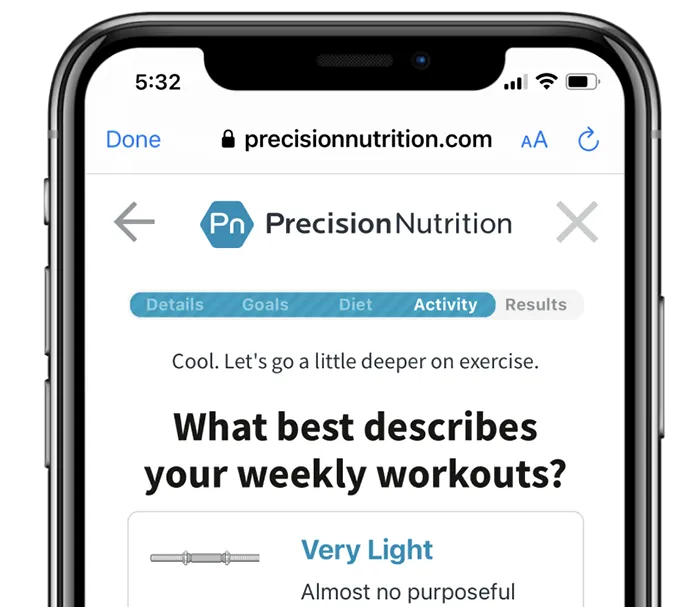
Built for Clients
& Coaches
Whether you’re calculating your macros for yourself or for someone you’re coaching, our macro calculator is the perfect tool
What Exactly Are Macros and Why Track Them?
There are three major macronutrients: protein, carbohydrates, and fat. (The fourth macronutrient is alcohol.) Your body breaks down the macronutrients you eat into compounds used to help create energy, build body structures, create chemical reactions, and stimulate the release of hormones. Which means macros can impact how you feel, perform, and even behave. When you track macros, you’re automatically tracking your calorie intake and getting the appropriate amount of macronutrients for your body, goals, and preferences.
Number of Calories Per Macronutrient
Why does tracking macros help you automatically track calories? Because each macronutrient provides a certain number of calories:
- 1 gram of protein = 4 calories
- 1 gram of carbohydrate = 4 calories
- 1 gram of fat = 9 calories
- (1 gram of alcohol = 7 calories)
By logging how many grams of each macronutrient you eat every day, you’ll know the number of calories you consume from protein, carbohydrates, and fat, respectively—and, as a result, the total number of calories you’re consuming. Hitting your macro and calorie targets helps you support your appetite, hormones, and energy levels, and ultimately your health and fitness goals.
Macronutrient Ratios
Your macronutrient ratio is how many calories in your diet come from each of the main macronutrients. For example, let’s say you eat:
- 30% of your calories from protein
- 40% of your calories from carbohydrate
- 30% of your calories from fat
Your macronutrient ratio would then be: 30:40:30.
By adjusting your macronutrient ratio based on your age, sex, activity levels, goals, and preferences, you can optimize your eating plan.
If you’re trying to lose weight, you might eat a higher proportion of protein, since it can help you feel satisfied longer after meals. Or if you’re a very physically active athlete, you might want a higher ratio of carbohydrates to meet your greater energy demands.

How to Track Macros:
The Hand Portion Method
Our macro and nutrition calculator aims to help people eat the right amount of food without the burden of having to weigh and measure every morsel. It gives personalized targets for both daily calories and macros and hand portions, so you can use whichever method you prefer.
This hand portion system—developed by Precision Nutrition—allows you to use your own hand as a personalized, portable portioning tool. Rather than measuring your food, you’re using your hand to gauge portion size. It’s highly effective for food tracking because your hand is proportionate to your body, its size never changes, and it’s always with you. Here’s a snapshot of how it works, and you can get all your questions answered in our Hand Portion FAQ.
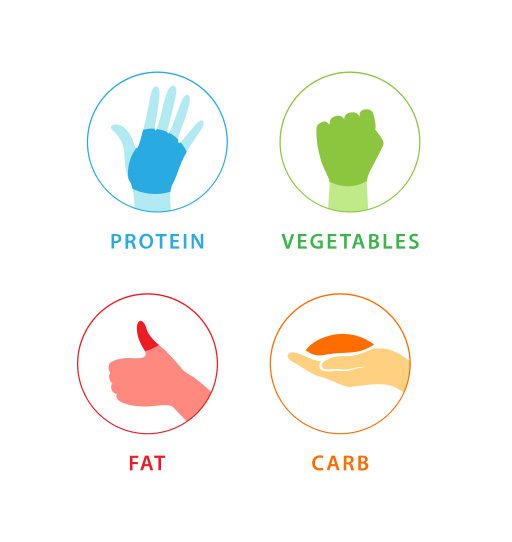
*Based on the macro calculator’s output, all you have to do is eat the recommended number of each hand portion daily.
Macro Calculator
& Tracking FAQs
If you still have questions, check out these FAQs or browse our detailed guide on macro math and portion sizes.
How Does the Nutrition Calculator Determine My Calorie & Macro Needs?
This calculator uses the same baseline algorithm as the Precision Nutrition Weight Loss Calculator to calculate maintenance, weight loss, and weight gain calorie needs. It factors in the adaptive nature of your metabolism to predict how long it’ll take you to reach your bodyweight goal.
This algorithm is a mathematically validated model based on the NIH Body Weight Planner and adapted from research collected at the National Institutes of Diabetes and Digestive and Kidney Disease.
The macronutrients are calculated by many rules:
- Protein is set on a grams per pound of bodyweight basis, at a range of 0.65-1.35 g/lb, depending upon sex, weight, goal, and activity level. (For very low-fat and very low-carb options, protein is set at 20% of calories, not on a bodyweight basis.)
- Protein needs are also set on a sliding scale since, on average, even within the same goal and activity level, heavier folks would generally have a greater body fat percentage than lighter folks. Therefore, they require a smaller amount of protein on a grams per pound basis (though still higher on an absolute basis).
- Then, dependent upon the Macronutrient Preference chosen, either fat or carbohydrates are set at a particular percent of calories (e.g. “Low-fat” is set at 20% calories from fat, and “Low-carb” is at 20% calories from carbs) to determine the allocation of the remaining non-protein calories.
- Finally, the rest of the calories are filled out by the remaining macronutrient (either fat or carbs). Note, if “Balanced” was chosen, the non-protein calories are split evenly between fats and carbs.
If you enter a custom macronutrient percentage, those ratios are used to determine all macronutrient and hand-portion calculations, overriding the macronutrient math outlined above. (Calories will not be changed.)
How Does Changing My Goals Change the Calculator Output?
For people looking to improve health, the macro calculator uses the weight maintenance calories determined by the validated mathematical model inherent to the NIH algorithm.
For people looking to lose body fat or gain muscle, the macro calculator uses the validated mathematical model inherent to the NIH algorithm. This takes into account a host of anthropometric data, time desired to reach a goal, and the adaptive nature of human metabolism.
For people looking to improve athletic performance, the macro calculator adds an additional 10% more calories to the weight maintenance requirements calculated by the NIH algorithm. This supports the increased demands of athletic performance.
For people looking to change their body composition, the macro calculator lowers calorie needs by 10% from the weight maintenance requirements calculated by the NIH algorithm. This’ll help facilitate simultaneous fat loss and muscle growth. It should be noted that this approach is most appropriate for individuals who don’t wish to change their body weight by more than 10 to 15 pounds, yet want to improve their body composition.
How Do I Accurately Input My Exercise in the Macro Calculator?
In the macro calculator, you’ll see the terms “gentle,” “moderate,” and “strenuous.” These describe the intensity of your activity.
Examples of moderate to strenuous activity include:
- Resistance training
- Interval or Circuit training
- Crossfit
- Running or jogging
- Rowing
- Cycling
- Swimming
- Team sports (e.g. basketball, hockey, soccer, tennis, etc.)
- Hiking
- Jump Rope
- Group classes (spin, dance, etc.) and bootcamps
- Yoga (power, bikram)
Examples of gentle activity include:
- Walking
- Yoga (hatha, vinyasa, ashtanga, etc.)
- Pilates
- Golfing
- Biking, swimming or cycling at a leisurely pace or for pleasure
Gentle activities are fantastic, but they don’t bump up your calorie needs like higher-intensity activity does. So it’s most important to count how many hours you spend engaged in moderate to strenuous exercise. When in doubt, it’s better to underestimate your activity rather than overestimate it.
Here’s an example. Let’s say your week includes:
- Walking for 20 minutes, 2 times
- Vinyasa yoga for 30 minutes, 2 times
- Resistance training for 45 minutes, 2 times
- Running for 30 minutes, 3 times
That’d count as:
- 4 gentle activities (vinyasa yoga x 2; walking x 2) for a total of 100 minutes (1.66 hours)
- 5 moderate to strenuous activities (resistance training x 2, running x 3) for a total of 180 minutes (3 hours)
Which means you’d select your activity level as “Moderate” under the purposeful exercise question. (Defined as moderate to strenuous activity 3 to 4 hours per week.)
How Effective are Hand Portions for Tracking Macros?
Our research shows hand portions are 95 percent as accurate (or better) as carefully weighing, measuring, and tracking. With substantially less effort and time involved.
Plus, our hand portion tracking system allows you to easily adjust your intake to further optimize your results.
We Can Support You on Your Fitness Journey
A new nutrition and fitness plan can seem daunting, but you don’t have to do it on your own. Here at Precision Nutrition, we can help you build habits that improve your physical and mental health, bolster your immunity, help you better manage your stress, and get sustainable results. Explore our personal coaching programs or subscribe to our email newsletter to learn more about the next step you can take with Precision Nutrition.
PERSONAL COACHING FOR WOMEN |
PERSONAL COACHING FOR MEN
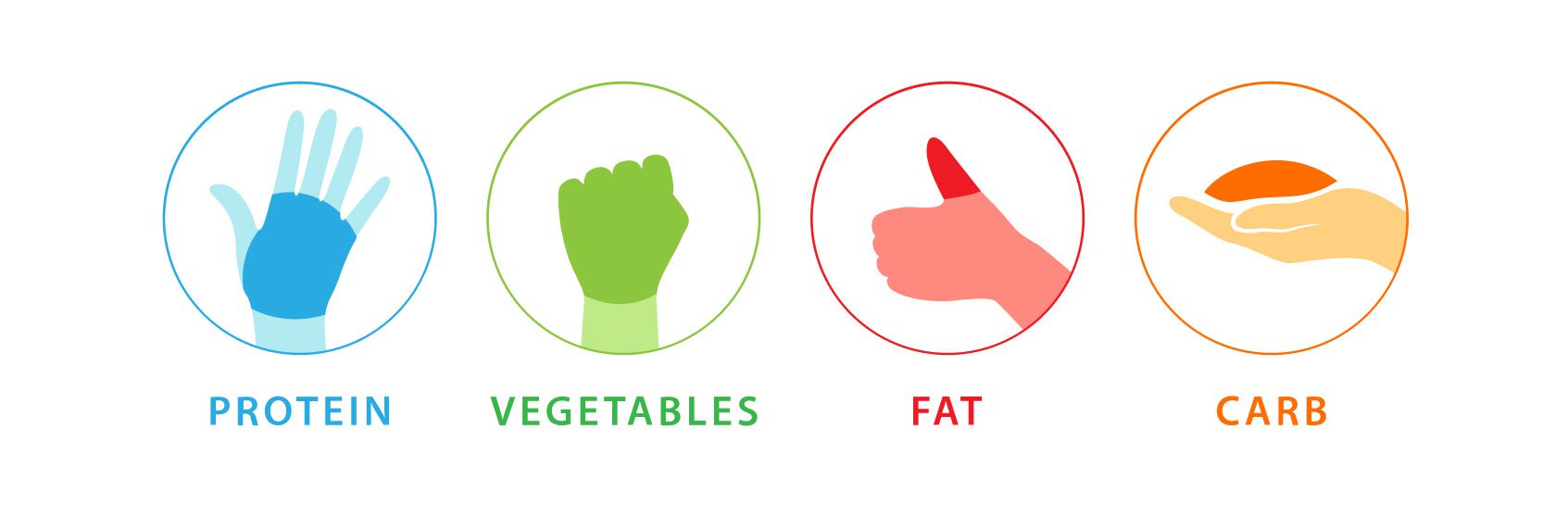
Share